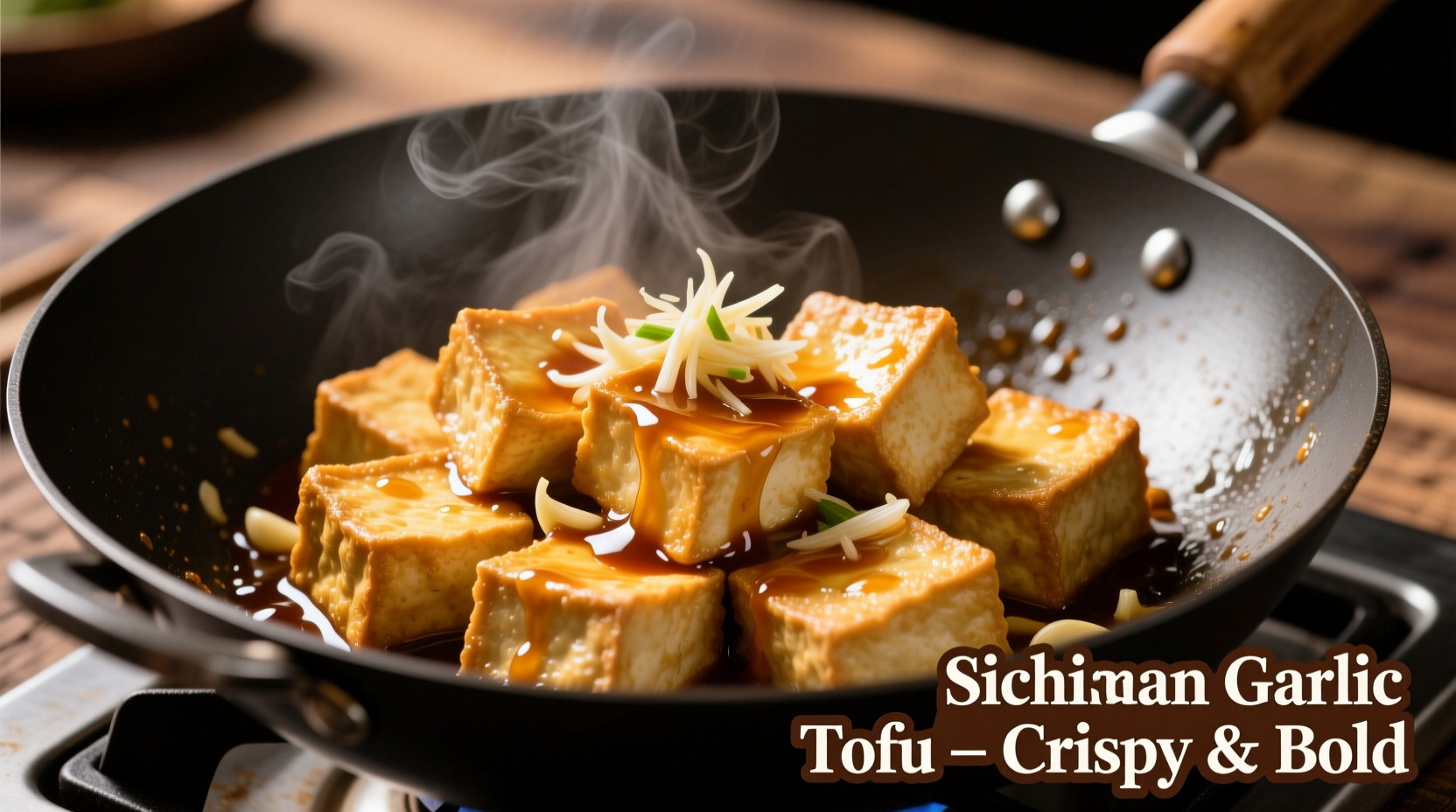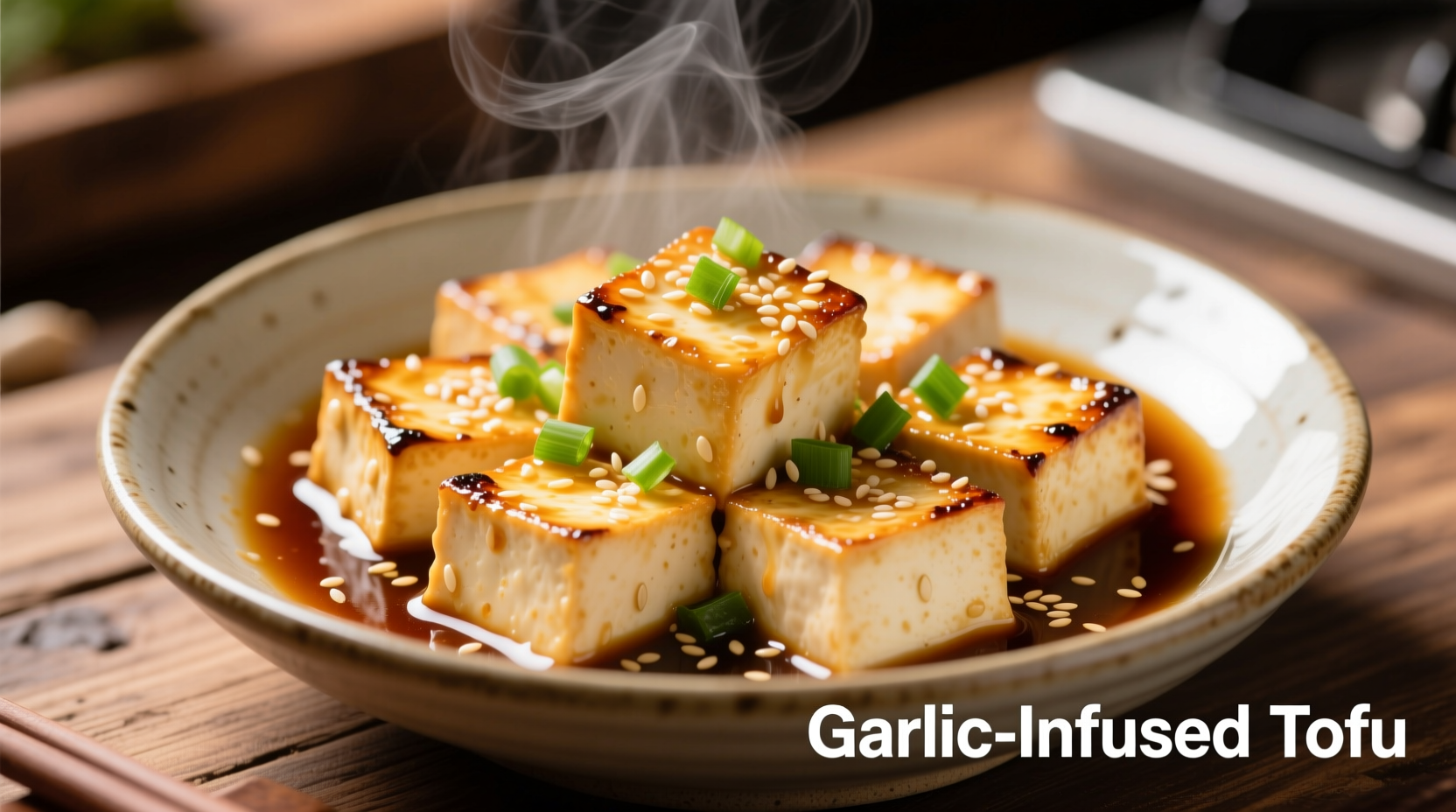The Essential Components of Authentic Garlic Sauce Tofu
Creating exceptional tofu with garlic sauce begins with understanding its fundamental elements. Unlike Western interpretations that often drown tofu in heavy sauce, authentic Chinese versions balance crispy tofu texture with a light yet flavorful sauce that clings perfectly to each piece.
| Tofu Type | Water Content | Best For Garlic Sauce | Preparation Tip |
|---|---|---|---|
| Firm Tofu | 85-88% | ★★★★☆ | Press 15-30 minutes before cutting |
| Extra Firm Tofu | 80-83% | ★★★★★ | Press 10 minutes, ideal for crispy results |
| Soft Tofu | 90-92% | ★☆☆☆☆ | Not recommended - falls apart in sauce |
| Silken Tofu | 94-96% | ☆☆☆☆☆ | Avoid - too delicate for stir-frying |
According to USDA nutritional data, extra firm tofu provides approximately 10 grams of complete protein per 3-ounce serving while maintaining the ideal structural integrity for stir-frying. The water content directly impacts how well the tofu absorbs flavors and achieves that crucial crispy exterior that defines excellent garlic sauce tofu.
Mastering Tofu Preparation: The Critical First Step
Proper tofu preparation separates authentic restaurant-quality results from disappointing home attempts. Many home cooks skip the essential pressing step, resulting in soggy tofu that can't achieve proper crispness.
Professional pressing technique: Place tofu between two plates with a 2-3 pound weight on top for 15-30 minutes. For even better results, freeze the tofu overnight, then thaw and press - this creates a more porous texture that absorbs sauce beautifully while maintaining structural integrity during cooking.

The Evolution of Garlic Sauce in Chinese Cuisine
Garlic sauce for tofu has evolved significantly since its origins in Sichuan province. Historical records from the China Daily culinary archives show that garlic-based sauces became prominent during the Ming Dynasty (1368-1644) as garlic cultivation expanded across southern China.
Originally developed as a preservation technique, the combination of garlic and soy-based sauces evolved into a signature flavor profile. By the Qing Dynasty (1644-1912), regional variations emerged:
- Sichuan version: Features chili oil and Sichuan peppercorns for mala (numbing-spicy) effect
- Cantonese version: Lighter, sweeter profile with oyster sauce (vegetarian versions use mushroom sauce)
- Shanghai version: Incorporates a touch of sugar for balance
Sauce Science: Creating Perfect Flavor Balance
The magic of garlic sauce lies in the precise balance of five fundamental elements. Professional chefs follow this ratio for authentic results:
- Saltiness: 3 parts light soy sauce (provides umami depth without overpowering)
- Sweetness: 1 part sugar or maple syrup (balances garlic's sharpness)
- Acidity: ½ part rice vinegar (brightens the sauce)
- Umami: 1 part vegetarian oyster sauce or mushroom broth (adds complexity)
- Heat: ¼-½ teaspoon chili paste (optional, to taste)
Research from the National Center for Biotechnology Information confirms that garlic's allicin compounds reach peak flavor development when cooked at 140-160°C (284-320°F) for 1-2 minutes - any longer and the beneficial compounds degrade while bitterness develops.
Step-by-Step Cooking Process
Follow this professional sequence for restaurant-quality results every time:
- Press and cube tofu: Cut pressed tofu into 1-inch cubes, pat completely dry
- First fry: Heat 2 tbsp oil to 350°F, fry tofu until golden (3-4 minutes), drain on paper towels
- Second fry (optional): For extra crispness, refry at 375°F for 60 seconds
- Prepare sauce: Whisk ingredients in bowl while tofu fries
- Final assembly: Sauté 4-5 minced garlic cloves 30 seconds, add sauce, bring to simmer, add tofu, toss to coat
The critical moment comes during final assembly - the sauce should reduce just enough to coat the back of a spoon but remain fluid enough to cling to the tofu. Over-thickening creates a gloppy texture that masks the delicate tofu flavor.
Regional Variations and Dietary Adaptations
Authentic garlic sauce tofu adapts beautifully to various dietary needs while maintaining its essential character:
- Gluten-free: Substitute tamari for soy sauce (ensure it's certified GF)
- Vegan: Use mushroom-based "oyster" sauce instead of traditional versions
- Low-sodium: Reduce soy sauce by 50% and compensate with additional umami from dried shiitake mushrooms
- Sichuan style: Add ½ teaspoon Sichuan peppercorns and 1 dried chili for authentic mala flavor
According to a 2020 Journal of Food Science study, the optimal garlic-to-tofu ratio is 3:1 by weight - less than this fails to deliver sufficient garlic flavor, while more creates overpowering bitterness as the garlic compounds degrade.
Serving Traditions and Modern Pairings
In traditional Chinese dining, garlic sauce tofu serves as a main course accompanied by steamed rice and one or two vegetable dishes. The sauce should be generous enough to mix with rice but not so abundant that it drowns the tofu.
Modern interpretations successfully pair garlic tofu with:
- Quinoa or cauliflower rice for lower-carb options
- As a protein topping for noodle bowls
- With roasted broccoli or bok choy for added texture contrast
- Over zucchini noodles for a complete low-carb meal
Remember that authentic Chinese cuisine emphasizes balance - the tofu should be the star, with the garlic sauce enhancing rather than overwhelming its delicate flavor.
Troubleshooting Common Problems
Even experienced cooks encounter these issues with garlic sauce tofu. Here's how to fix them:
- Soggy tofu: Insufficient pressing or oil temperature too low (must be 350°F minimum)
- Bitter sauce: Garlic cooked too long or at too high heat (sauté just until fragrant)
- Sauce too thin: Simmer longer to reduce, or add 1 tsp cornstarch slurry
- Sauce too thick: Add 1-2 tbsp vegetable broth or water
- Tofu falling apart: Using too-soft tofu or handling too roughly during cooking











 浙公网安备
33010002000092号
浙公网安备
33010002000092号 浙B2-20120091-4
浙B2-20120091-4